Uncertainty Analysis of Aircraft Center of Gravity Deviation and Passenger Seat Allocation Optimization
Abstract
:1. Introduction
2. Description and Model Formulation
2.1. The Compartment-Based AWB Model
2.2. The Row-Based AWB Model
3. Computational Experiments
3.1. Comparison of the CG Deviation
3.2. Comparison of Results with Different TCG
4. The Effect of Variances in Passenger Weight on CG
4.1. The Effect on the Mean
4.2. The Effect on the Standard Deviation
4.3. The Confidence Interval of the Mean of ΔCG
4.4. The Effect of the Number of Passengers Outside Effective Ranges
4.5. The Effect on the Mean
5. Discussion
6. Conclusions
Author Contributions
Funding
Data Availability Statement
Conflicts of Interest
References
- Idan, M.; Iosilevskii, G.; Nazarov, S. In-Flight Weight and Balance Identification Using Neural Networks. J. Aircr. 2004, 41, 137–143. [Google Scholar] [CrossRef]
- Zhang, J.; Shen, G.; Yang, L. New Hybrid Adaptive Control Approach for Aircraft with Centre of Gravity Variation. IET Control Theory Appl. 2012, 6, 2179–2187. [Google Scholar] [CrossRef]
- Yang, X.; Luo, M.; Zhang, J.; Yang, L. Aircraft Centre-of-Gravity Estimation Using Gaussian Process Regression Models. In Proceedings of the 2016 IEEE/CSAA International Conference on Aircraft Utility Systems (AUS), Beijing, China, 10–12 October 2016; pp. 991–995. [Google Scholar]
- Jumat, N.A.; Abdullah, E.J. Development of an Aircraft Load Planning System for Distribution of Passenger Baggage. Int. J. Eng. Technol. 2018, 7, 95–98. [Google Scholar] [CrossRef]
- Chaves, F.; Silvestre, M.; Gamboa, P. Preliminary Development of an Onboard Weight and Balance Estimator for Commercial Aircraft. Aerosp. Sci. Technol. 2018, 72, 316–326. [Google Scholar] [CrossRef]
- Zhao, X.; Yuan, Y.; Dong, Y.; Zhao, R. Optimization Approach to the Aircraft Weight and Balance Problem with the Centre of Gravity Envelope Constraints. IET Intell. Transp. Syst. 2021, 15, 1269–1286. [Google Scholar] [CrossRef]
- Ole, L.; Mikkelsen, G. Danish Operations Research Society Student Competition An Interactive System for the Loading of Cargo Aircraft. Eur. J. Oper. Res. 1980, 4, 367–373. [Google Scholar]
- Brosh, I. Optimal Cargo Allocation on Board a Plane: A Sequential Linear Programming Approach. Eur. J. Oper. Res. 1981, 8, 40–46. [Google Scholar] [CrossRef]
- Amiouny, S.V.; Bartholdi, J.J.; Vate, J.H.V.; Zhang, J. Balanced Loading. Oper. Res. 1992, 40, 238–246. [Google Scholar] [CrossRef]
- John, R.W.; Fadel, G.M. Packing and Optimizing the Center of Gravity Location Using a Genetic Algorithm. J. Comput. Ind. 1994, 11, 2–14. [Google Scholar]
- Mathur, K. An Integer-Programming-Based Heuristic for the Balanced Loading Problem. Oper. Res. Lett. 1998, 22, 19–25. [Google Scholar] [CrossRef]
- Heidelberg, K.R.; Parnell, G.S.; Ames, E.A., IV. Automated Air Load Planning. Nav. Res. Logist. 1998, 45, 751–768. [Google Scholar] [CrossRef]
- Dahmani, N.; Krichen, S. On Solving the Bi-Objective Aircraft Cargo Loading Problem. In Proceedings of the 2013 5th International Conference on Modeling, Simulation and Applied Optimization (ICMSAO 2013), Hammamet, Tunisia, 28–30 April 2013; pp. 1–6. [Google Scholar]
- Brandt, F.; Nickel, S. The Air Cargo Load Planning Problem—A Consolidated Problem Definition and Literature Review on Related Problems. Eur. J. Oper. Res. 2019, 275, 399–410. [Google Scholar] [CrossRef]
- Schultz, M.; Soolaki, M. Analytical Approach to Solve the Problem of Aircraft Passenger Boarding during the Coronavirus Pandemic. Transp. Res. Part C Emerg. Technol. 2021, 124, 102931. [Google Scholar] [CrossRef] [PubMed]
- Ren, X.; Pan, N.; Jiang, H. Differentiated Pricing for Airline Ancillary Services Considering Passenger Choice Behavior Heterogeneity and Willingness to Pay. Transp. Policy 2022, 126, 292–305. [Google Scholar] [CrossRef]
- Notomista, G.; Selvaggio, M.; Sbrizzi, F.; Di Maio, G.; Grazioso, S.; Botsch, M. A Fast Airplane Boarding Strategy Using Online Seat Assignment Based on Passenger Classification. J. Air Transp. Manag. 2016, 53, 140–149. [Google Scholar] [CrossRef]
- Birolini, S.; Besana, E.; Cattaneo, M.; Redondi, R.; Sallan, J.M. An Integrated Connection Planning and Passenger Allocation Model for Low-Cost Carriers. J. Air Transp. Manag. 2021, 99, 102160. [Google Scholar] [CrossRef]
- Wong, W.H.; Zhang, A.; Van Hui, Y.; Leung, L.C. Optimal Baggage-Limit Policy: Airline Passenger and Cargo Allocation. Transp. Sci. 2009, 43, 355–369. [Google Scholar] [CrossRef]
- Ma, H.-L.; Sun, Y.; Mo, D.Y.; Wang, Y. Impact of Passenger Unused Baggage Capacity on Air Cargo Delivery. In Annals of Operations Research; Springer: Berlin/Heidelberg, Germany, 2023; pp. 1–17. [Google Scholar] [CrossRef]
- Liu, Y.; Cheng, X.; Tang, D.; Wang, X. Optimization of Cabin Seating Arrangement Strategies Based on the Wells-Riley Risk Theory. PLoS ONE 2023, 18, e0294345. [Google Scholar] [CrossRef]
- Qiu, J.; Wu, C.-F.; Wu, A.; Liu, L. Smart Airplane Seat Assignment System for Passengers’ Multimedia Preferences. In Proceedings of the 2017 IEEE International Conference on Smart Computing (SMARTCOMP), Hong Kong, China, 29–31 May 2017; pp. 1–6. [Google Scholar]
- Castro, J.; Sarachaga, F. An Online Optimization-Based Procedure for the Assignment of Airplane Seats. TOP 2021, 29, 204–247. [Google Scholar] [CrossRef]
- Milne, R.J.; Cotfas, L.-A.; Delcea, C.; Crăciun, L.; Molănescu, A.G. Airplane Seating Assignment Greedy Algorithms That Separate Passengers Likely to Be Susceptible to Infectious Disease from Those Likely to Be Infectious. IEEE Access 2024. [Google Scholar] [CrossRef]
- Birge, J.R.; Louveaux, F. Introduction to Stochastic Programming; Springer: New York, NY, USA, 2011. [Google Scholar] [CrossRef]
- Hannan, M.A.; Faisal, M.; Ker, P.J.; Begum, R.A.; Dong, Z.Y.; Zhang, C. Review of Optimal Methods and Algorithms for Sizing Energy Storage Systems to Achieve Decarbonization in Microgrid Applications. Renew. Sustain. Energy Rev. 2020, 131, 110022. [Google Scholar] [CrossRef]
- Crainic, T.G.; Fomeni, F.D.; Rei, W. Multi-Period Bin Packing Model and Effective Constructive Heuristics for Corridor-Based Logistics Capacity Planning. Comput. Oper. Res. 2021, 132, 105308. [Google Scholar] [CrossRef]
- Crainic, T.G.; Perboli, G.; Rei, W.; Rosano, M.; Lerma, V. Capacity Planning with Uncertainty on Contract Fulfillment. Eur. J. Oper. Res. 2024, 314, 152–175. [Google Scholar] [CrossRef]
- Melis, D.J.; Silva, J.M.; Silvestre, M.A.; Yeun, R. The Effects of Changing Passenger Weight on Aircraft Flight Performance. J. Transp. Health 2019, 13, 41–62. [Google Scholar] [CrossRef]
- Civil Aviation Administration of China. Regulations on Aircraft Weight and Balance Control (Civil Aviation Regulation (2019) No. 61) [s]. 2019. Available online: https://www.caac.gov.cn/XXGK/XXGK/GFXWJ/201911/t20191104_199320.html (accessed on 25 March 2024).




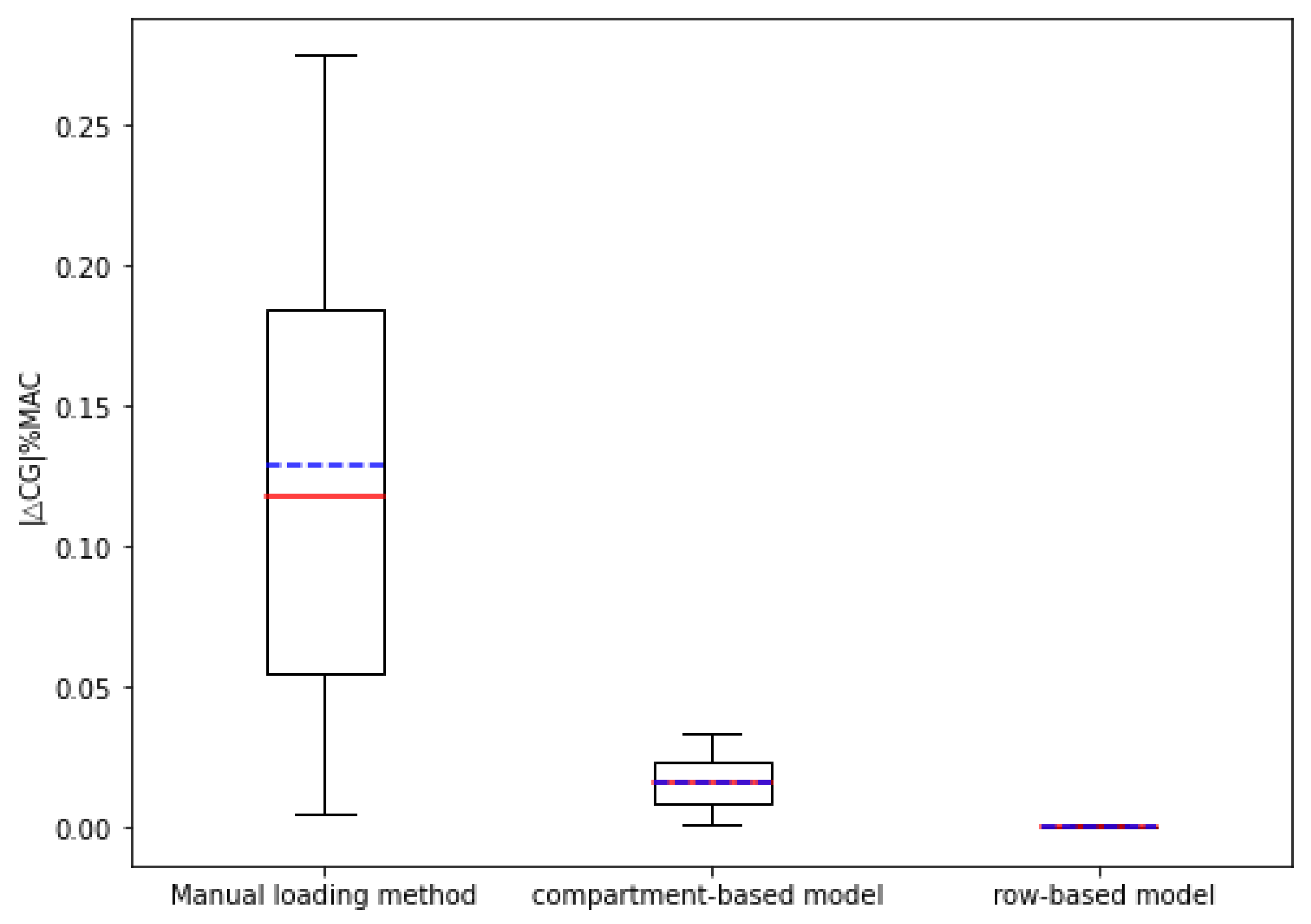
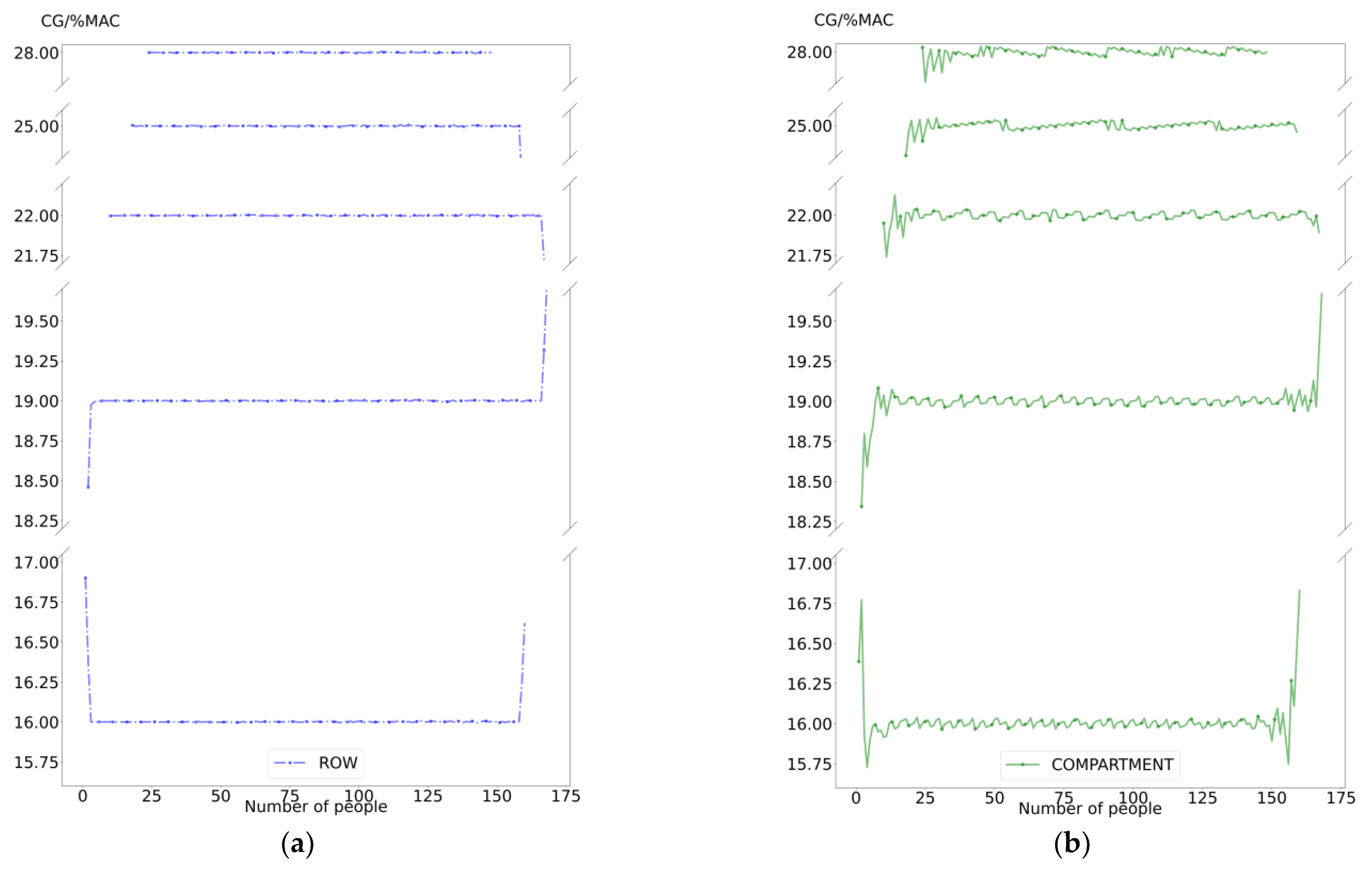
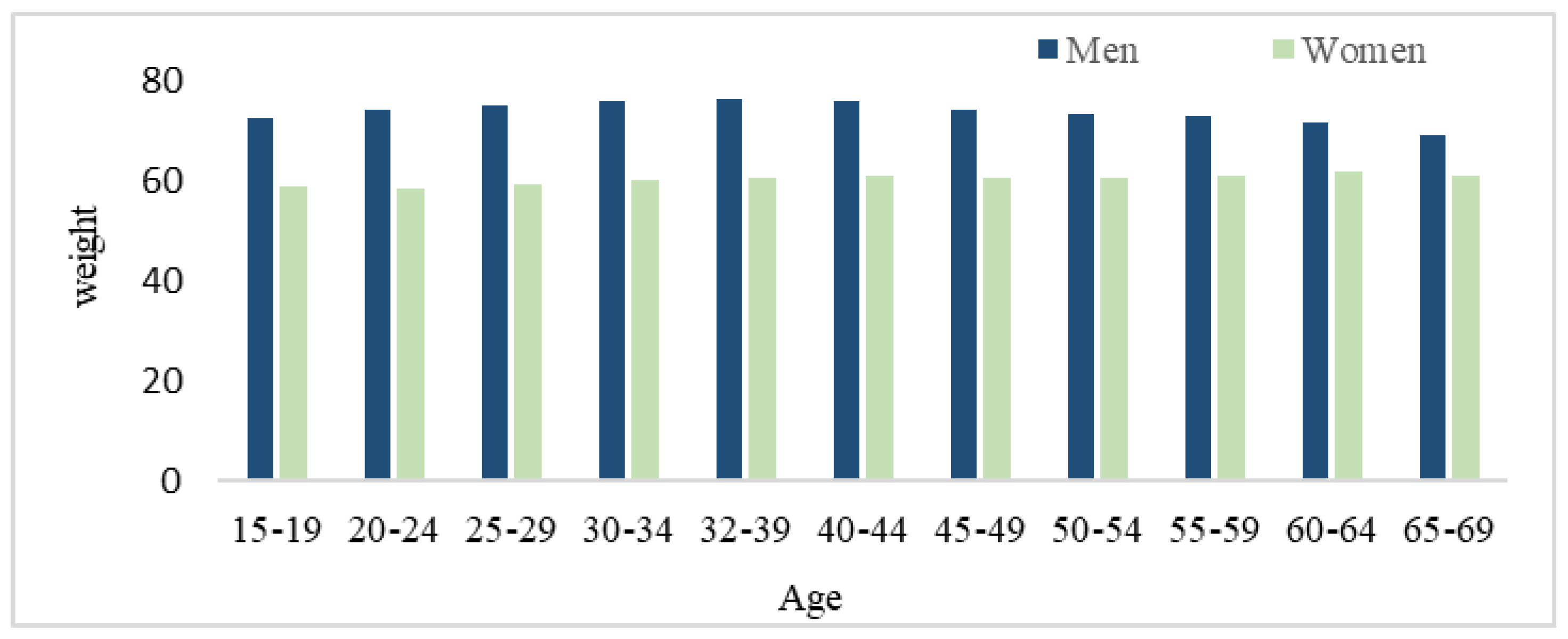

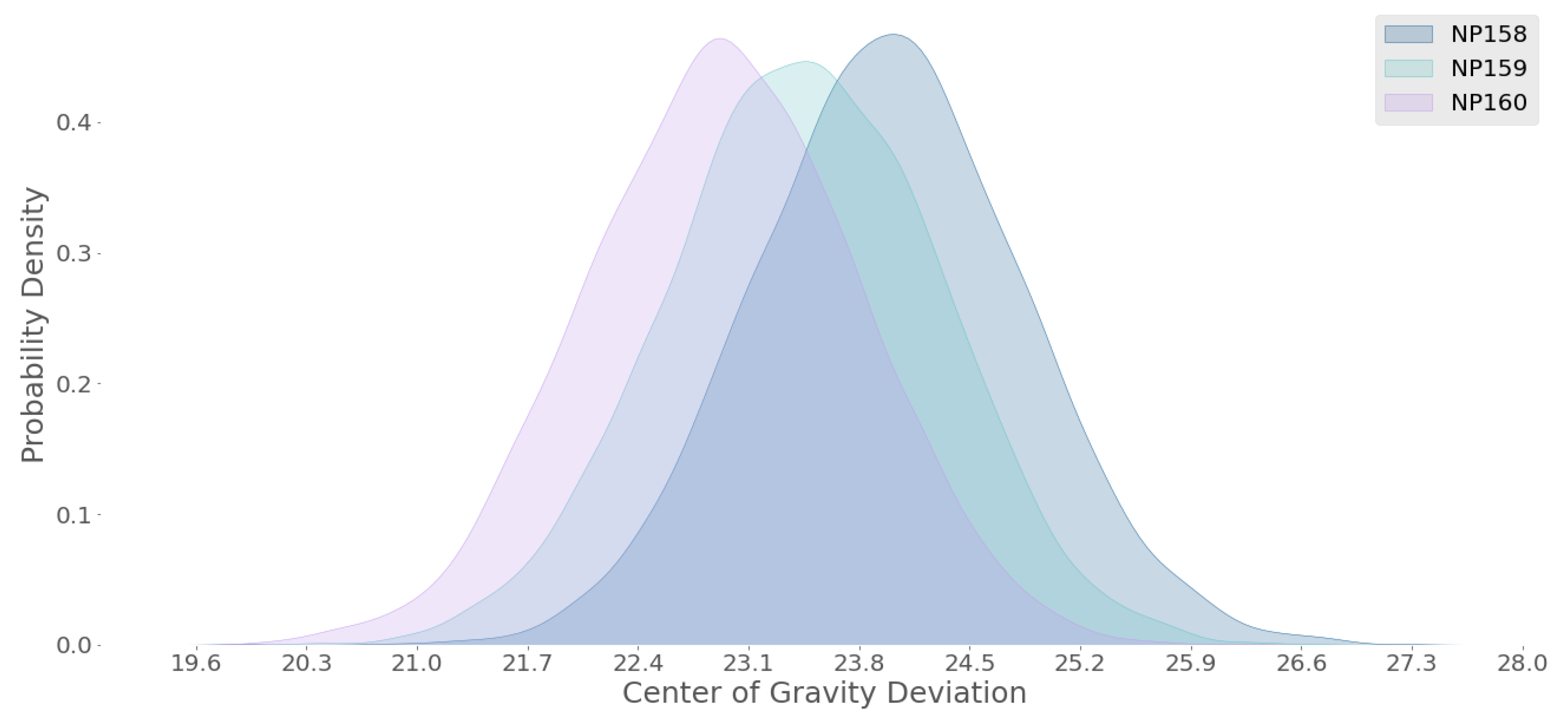
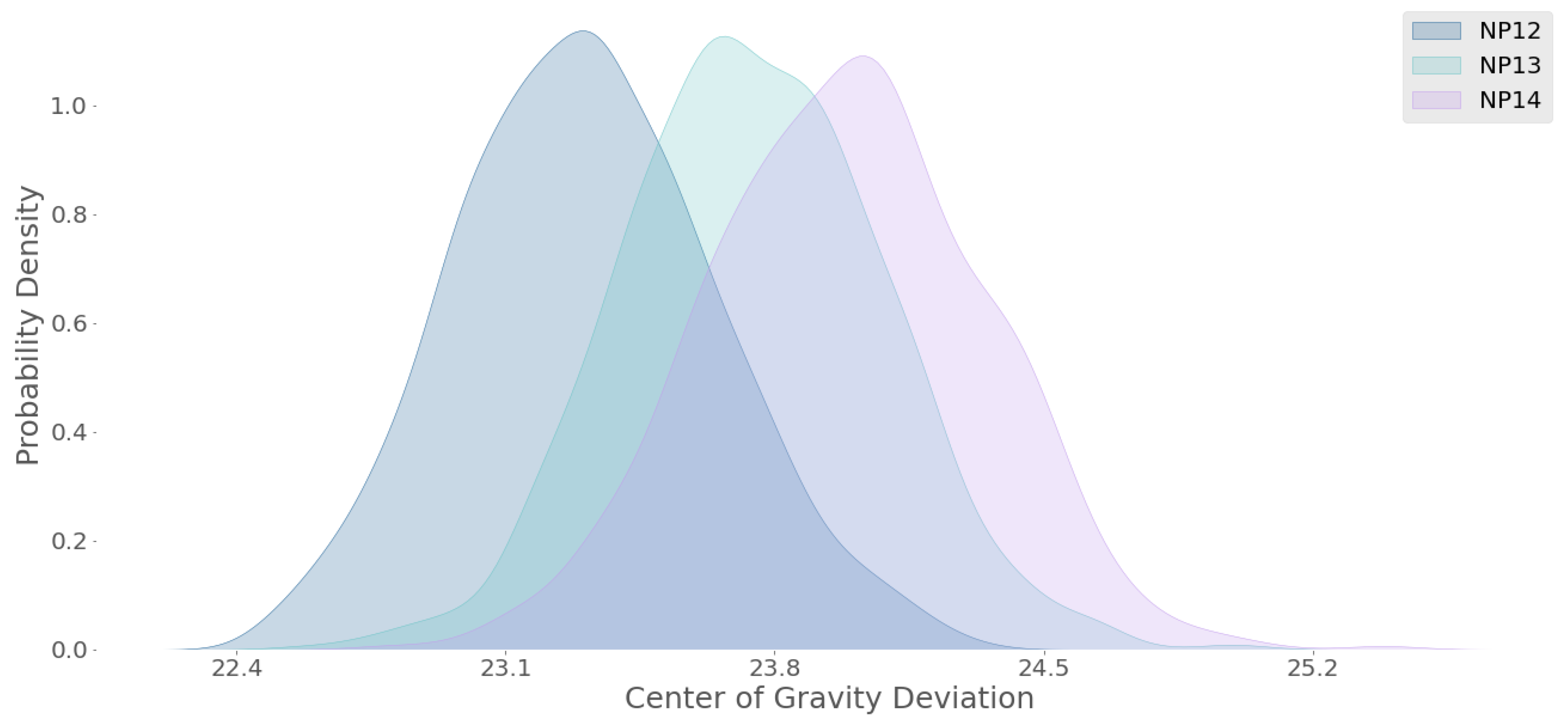

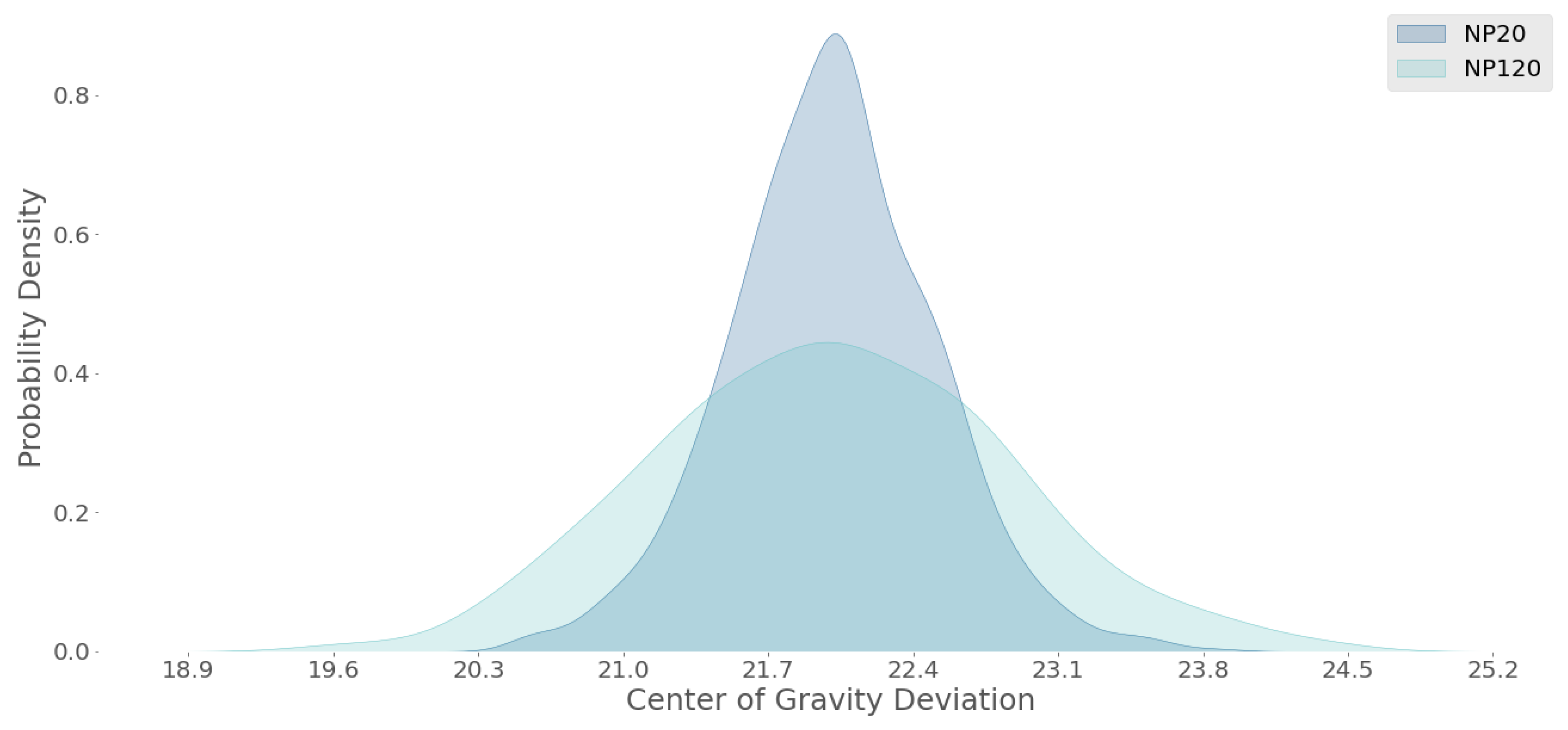


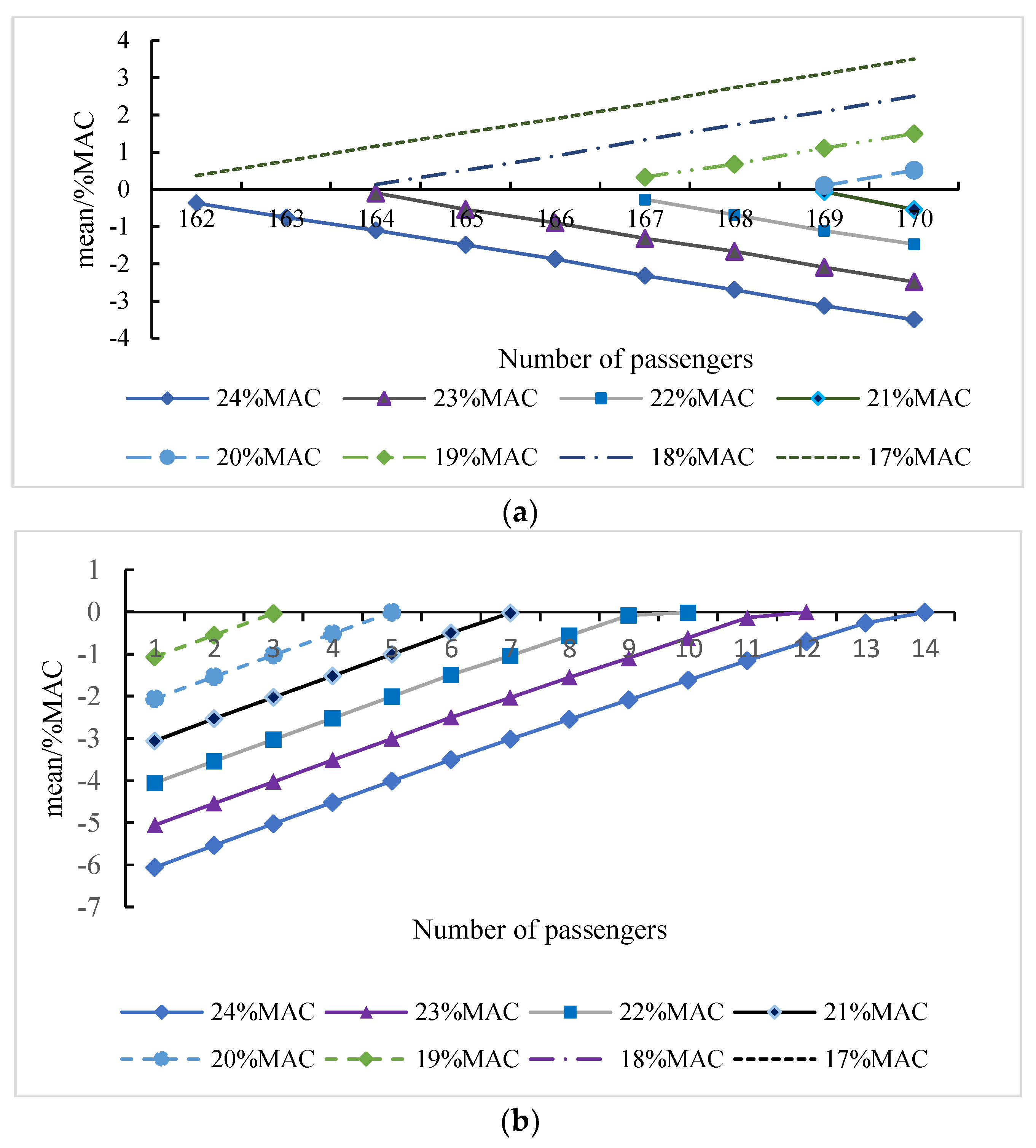
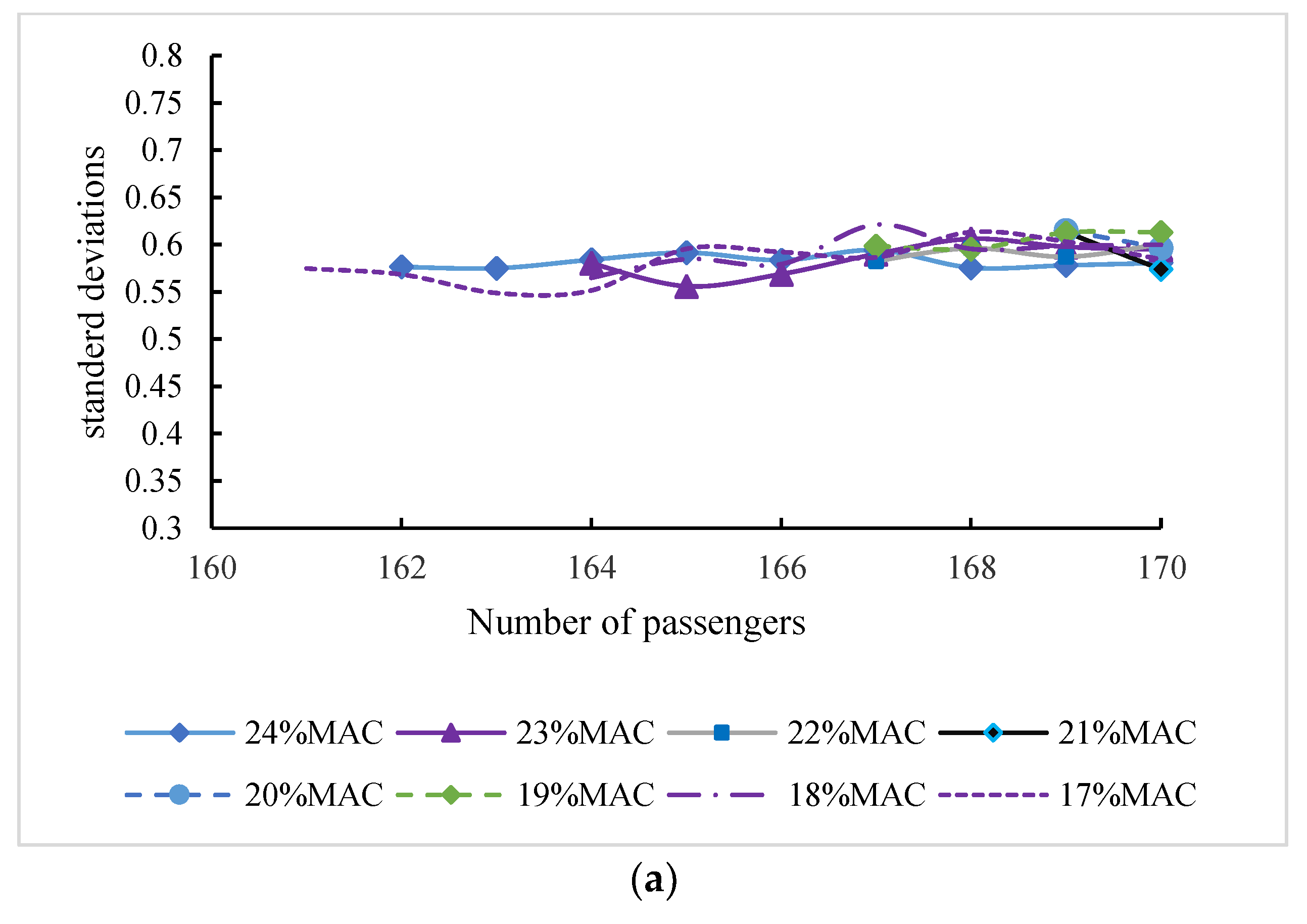
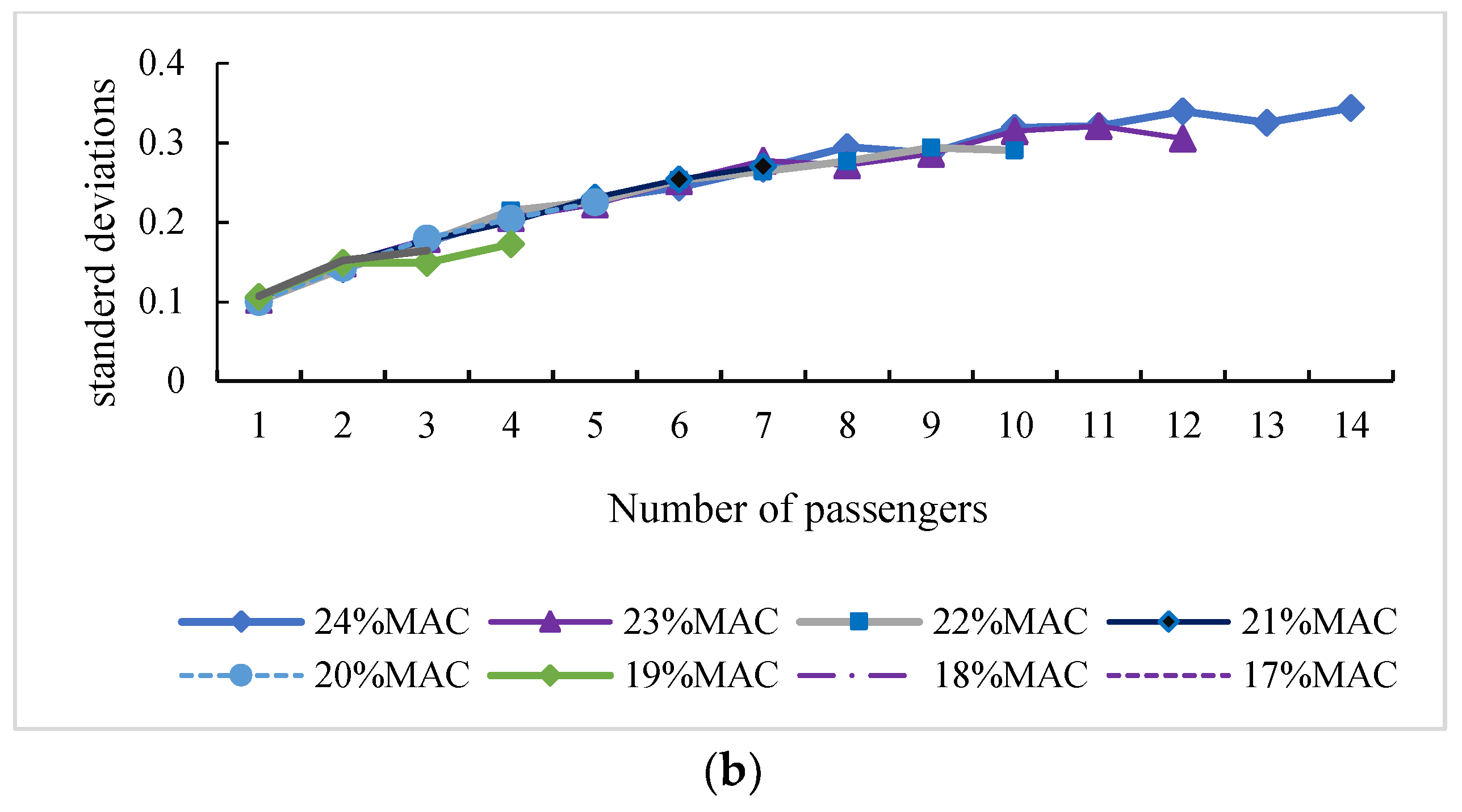
| Number of Passengers | |ΔCG| (%MAC) | ||
|---|---|---|---|
| Manual Loading Method | Compartment-Based Model | Row-Based Model | |
| 30 | 0.122 | 0.00531 | 0.000109 |
| 35 | 0.105 | 0.0211 | 0.000215 |
| 40 | 0.200 | 0.0160 | 0.000534 |
| 45 | 0.0557 | 0.00400 | 0.000212 |
| 50 | 0.0339 | 0.0180 | 0.000104 |
| 55 | 0.113 | 0.0332 | 0.000416 |
| 60 | 0.048 | 0.0242 | 0.000311 |
| 65 | 0.184 | 0.00890 | 5.91 × 10−5 |
| 70 | 0.168 | 0.0299 | 0.000304 |
| 75 | 0.176 | 0.0261 | 0.000404 |
| 80 | 0.0662 | 0.0111 | 0.000101 |
| 85 | 0.0512 | 0.0035 | 0.000198 |
| 90 | 0.0462 | 0.018 | 0.000492 |
| 95 | 0.187 | 0.0133 | 0.000196 |
| 100 | 0.141 | 0.00108 | 9.67 × 10−5 |
| 105 | 0.0901 | 0.0152 | 0.000385 |
| 110 | 0.275 | 0.0292 | 0.000287 |
| 115 | 0.267 | 0.0234 | 5.46 × 10−5 |
| 120 | 0.252 | 0.00941 | 0.000282 |
| 125 | 0.0043 | 0.00443 | 0.000375 |
| mean | 0.12928 | 0.0157665 | 0.00025677 |
| variance | 0.000581 | 0.009531514 | 0.000141822 |
| Number of Passengers | Solution Time (s) | |
|---|---|---|
| The Compartment-Based Model | The Row-Based Model | |
| 30 | 0.0130 | 1.000 |
| 35 | 0.0239 | 1.010 |
| 40 | 0.0199 | 1.008 |
| 45 | 0.0170 | 1.023 |
| 50 | 0.0139 | 1.036 |
| 55 | 0.0150 | 1.044 |
| 60 | 0.0199 | 1.036 |
| 65 | 0.0270 | 0.0300 |
| 70 | 0.0180 | 1.016 |
| 75 | 0.0189 | 1.026 |
| 80 | 0.026 | 1.008 |
| 85 | 0.0269 | 1.008 |
| 90 | 0.0189 | 1.013 |
| 95 | 0.0160 | 1.009 |
| 100 | 0.0250 | 1.009 |
| 105 | 0.033 | 1.010 |
| 110 | 0.0230 | 1.010 |
| 115 | 0.0239 | 0.0540 |
| 120 | 0.0279 | 1.009 |
| 125 | 0.0169 | 1.013 |
| mean | 0.0212 | 0.9186 |
| variance | 0.005253 | 0.292435 |
| Confidence Level K | The Value of Z | Confidence Interval |
|---|---|---|
| 90% | 1.5675 | [−1.9243, 1.5243] |
| 95% | 1.862 | [−2.2482, 1.8482] |
| 99% | 2.576 | [−3.0336, 2.6336] |
| Target Center of Gravity (%MAC) | Number of Passengers | Confidence Levels and Intervals | ||
|---|---|---|---|---|
| 90% | 95% | 99% | ||
| 17 | 169 | [−4.0254, −2.2133] | [−4.1958, −2.0430] | [−4.6086, −1.6302] |
| 170 | [−4.4071, −2.5868] | [−4.5781, −2.4158] | [−4.9927, −2.0012] | |
| 18 | 169 | [−3.0264, 1.1528] | [−3.2024, −0.9768] | [−3.6291, −0.5501] |
| 170 | [−3.4133, −1.5488] | [−3.5885, −1.3736] | [−4.0131, −0.9490] | |
| 19 | 169 | [−2.0250, −0.1844] | [−2.1979, −0.0115] | [−2.6171, 0.4077] |
| 170 | [−2.4089, −0.5266] | [−2.5857, −0.3498] | [−3.0144, 0.0789] | |
| 20 | 169 | [−1.0204, 0.9022] | [−1.2010, 1.0828] | [−1.6388, 1.5207] |
| 170 | [−1.4354, 0.3634] | [−1.6044, 0.5324] | [−2.0141, 0.9421] | |
| 21 | 169 | [−0.8607, 1.0669] | [−1.0418, 1.2480] | [−1.4808, 1.6870] |
| 170 | [−0.4202, 1.4500] | [−0.5959, 1.6256] | [−1.0218, 2.0516] | |
| 22 | 169 | [0.1535, 2.0743] | [−0.0269, 2.2547] | [−0.4644, 2.6922] |
| 170 | [0.5382, 2.4601] | [0.3577, 2.6406] | [−0.0800, 3.0783] | |
| 23 | 169 | [1.1520, 3.0292] | [0.9756, 3.2056] | [0.5481, 3.6331] |
| 170 | [1.5648, 3.4454] | [1.3881, 3.6220] | [0.9598, 4.0503] | |
| 24 | 169 | [2.1557, 4.0464] | [1.9780, 4.2240] | [1.5474, 4.6547] |
| 170 | [2.5834, 4.4156] | [2.4113, 4.5877] | [1.9940, 5.0050] | |
| Target Center of Gravity (%MAC) | Number of Passengers | Confidence Levels and Intervals | ||
|---|---|---|---|---|
| 90% | 95% | 99% | ||
| 17 | 1 | [−0.2125, 0.1109] | [−0.2429, 0.1413] | [−0.3165, 0.2150] |
| 18 | 1 | [−0.1250, 0.1334] | [−0.1493, 0.1576] | [−0.2081, 0.2165] |
| 19 | 1 | [−1.2291, −0.8952] | [−1.2604, −0.8639] | [−1.3365, −0.7878] |
| 2 | [−0.7883, −0.3198] | [−0.8324, −0.2758] | [−0.9391, −0.1691] | |
| 20 | 1 | [−2.2150, −1.9011] | [−2.2445, −1.8716] | [−2.3160, −1.8001] |
| 2 | [−1.7591, −1.3127] | [−1.8010, −1.2707] | [−1.9027, −1.1690] | |
| 21 | 1 | [−3.2228, −2.8972] | [−3.2534, −2.8666] | [−3.3275, −2.7924] |
| 2 | [−2.7641, −2.2964] | [−2.8081, −2.2524] | [−2.9146, −2.1459] | |
| 22 | 1 | [−4.2114, −3.8953] | [−4.2411, −3.8656] | [−4.3131, −3.7936] |
| 2 | [−3.7644, −3.3193] | [−3.8062, −3.2775] | [−3.9075, −3.1762] | |
| 23 | 1 | [−5.2165, −4.8940] | [−5.2468, −4.8637] | [−5.3203, −4.7903] |
| 2 | [−4.7731, −4.3068] | [−4.8169, −4.2630] | [−4.9230, −4.1569] | |
| 24 | 1 | [−6.2248, −5.8958] | [−6.2557, −5.8650] | [−6.3306, −5.7901] |
| 2 | [−6.2814, −5.8393] | [−6.3230, −5.7977] | [−6.4237, −5.6970] | |
Disclaimer/Publisher’s Note: The statements, opinions and data contained in all publications are solely those of the individual author(s) and contributor(s) and not of MDPI and/or the editor(s). MDPI and/or the editor(s) disclaim responsibility for any injury to people or property resulting from any ideas, methods, instructions or products referred to in the content. |
© 2024 by the authors. Licensee MDPI, Basel, Switzerland. This article is an open access article distributed under the terms and conditions of the Creative Commons Attribution (CC BY) license (https://creativecommons.org/licenses/by/4.0/).
Share and Cite
Zhao, X.; Xiao, W. Uncertainty Analysis of Aircraft Center of Gravity Deviation and Passenger Seat Allocation Optimization. Mathematics 2024, 12, 1591. https://doi.org/10.3390/math12101591
Zhao X, Xiao W. Uncertainty Analysis of Aircraft Center of Gravity Deviation and Passenger Seat Allocation Optimization. Mathematics. 2024; 12(10):1591. https://doi.org/10.3390/math12101591
Chicago/Turabian StyleZhao, Xiangling, and Wenheng Xiao. 2024. "Uncertainty Analysis of Aircraft Center of Gravity Deviation and Passenger Seat Allocation Optimization" Mathematics 12, no. 10: 1591. https://doi.org/10.3390/math12101591
APA StyleZhao, X., & Xiao, W. (2024). Uncertainty Analysis of Aircraft Center of Gravity Deviation and Passenger Seat Allocation Optimization. Mathematics, 12(10), 1591. https://doi.org/10.3390/math12101591





